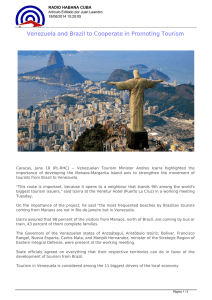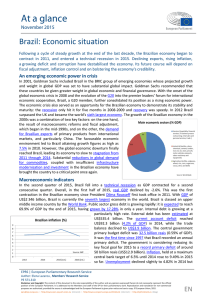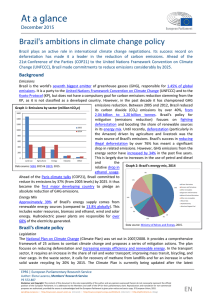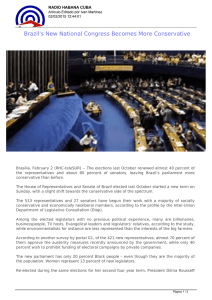Brazil Overview
Anuncio
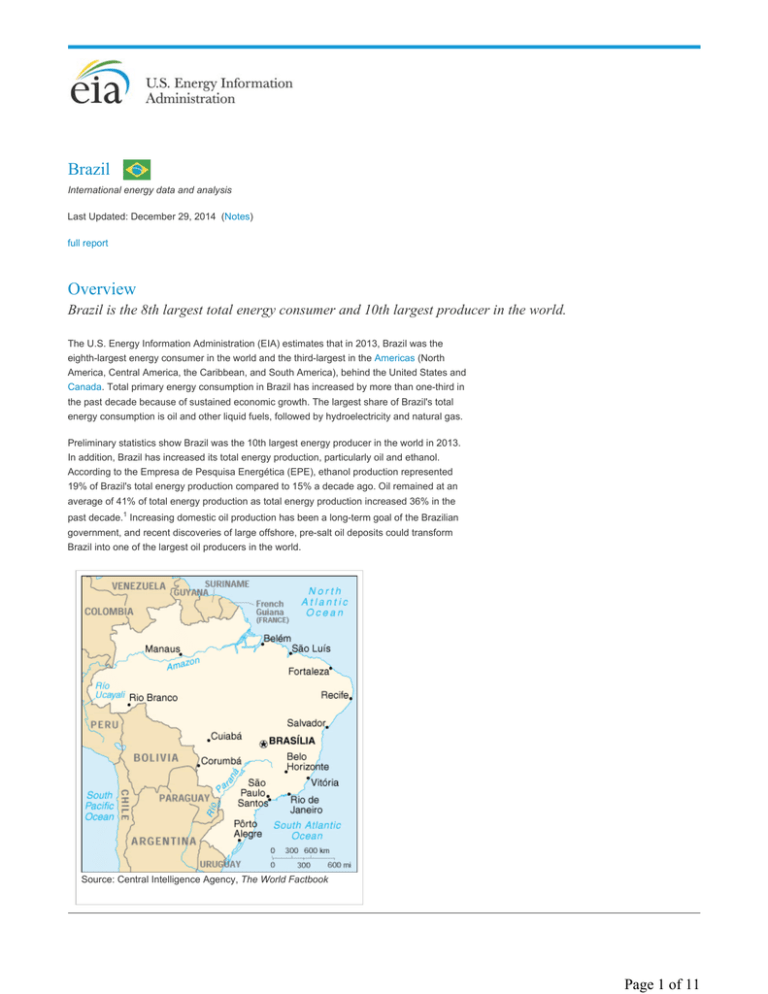
Brazil International energy data and analysis Last Updated: December 29, 2014 (Notes) full report Overview Brazil is the 8th largest total energy consumer and 10th largest producer in the world. The U.S. Energy Information Administration (EIA) estimates that in 2013, Brazil was the eighth-largest energy consumer in the world and the third-largest in the Americas (North America, Central America, the Caribbean, and South America), behind the United States and Canada. Total primary energy consumption in Brazil has increased by more than one-third in the past decade because of sustained economic growth. The largest share of Brazil's total energy consumption is oil and other liquid fuels, followed by hydroelectricity and natural gas. Preliminary statistics show Brazil was the 10th largest energy producer in the world in 2013. In addition, Brazil has increased its total energy production, particularly oil and ethanol. According to the Empresa de Pesquisa Energética (EPE), ethanol production represented 19% of Brazil's total energy production compared to 15% a decade ago. Oil remained at an average of 41% of total energy production as total energy production increased 36% in the past decade.1 Increasing domestic oil production has been a long-term goal of the Brazilian government, and recent discoveries of large offshore, pre-salt oil deposits could transform Brazil into one of the largest oil producers in the world. Source: Central Intelligence Agency, The World Factbook Page 1 of 11 Petroleum and other liquids Brazil was the largest producer of petroleum and other liquids in South America in 2013. Sector organization State-controlled Petróleo Brasileiro S.A.(Petrobras) is the dominant participant in Brazil's oil sector, holding important positions in upstream, midstream, and downstream activities. The company held a monopoly on oil-related activities in Brazil until 1997, when the government opened the sector to competition. Royal Dutch Shell was the first foreign crude oil producer in the country, and it has been joined by Chevron, Repsol, BP, Anadarko, El Paso, Galp Energia, Statoil, BG Group, Sinopec, ONGC, TNK-BP, among others. Competition in the sector is not just from foreign companies. Brazilian oil company OGX, which is staffed largely with former Petrobras employees, started to produce oil in the Campos Basin in 2011. The principal government agency charged with regulating and monitoring the oil sector is the the Agência Nacional do Petróleo, Gás Natural e Biocombustíveis (ANP), which is responsible for issuing exploration and production licenses and ensuring compliance with relevant regulations. Recent legislation concerning pre-salt exploration and production has changed the operating environment somewhat. See the "Presalt Oil" section for a full discussion. Reserves EIA estimates that in January 1, 2014, Brazil had 13.2 billion barrels of proved oil reserves. According to Brazil's oil regulator the Agência Nacional do Petróleo, Gás Natural e Biocombustíveis (ANP), Brazil had 15.6 billion barrels of proved oil reserves as of December 31, 2013, the second-largest level in South America after Venezuela. More than 94% of Brazil's reserves are located offshore, and 80% of all reserves are found offshore near the state of Rio de Janeiro. Offshore the state of Espirito Santo held the next largest accumulation at 9% of country's reserves.2 Production and consumption More than 91% of Brazil's oil production is offshore in very deep water and consists of mostly heavy grades. In 2013, Brazil produced 2.7 million barrels per day (bbl/d) of petroleum and other liquids, 2.0 million bbl/d was crude oil, and 527,000 bbl/d was biofuels. Petrobras accounted for 1.9 million bbl/d of domestic crude oil and natural gas liquids (NGL) production.3 Of Brazil's crude oil production, more than 91% was produced offshore, of which 79% was developed near the state of Rio De Janeiro, primarily in the Santos and Campos basins. A growing share of production is coming from Brazil's relatively recent discovery of oil deposits in the presalt layer. In 2013, crude oil production from the pre-salt layer was 303,000 bbl/d. This accounted for 15% of total production, a significant increase from 0.4% of total production in 2008 when oil from the presalt was first produced.4 Brazil's liquid fuels consumption continues to surpass its production. In 2013, Brazil's demand for liquid fuels broke the 3.0 million bbl/d mark, while its domestic production continued to remain relatively unchanged at about 2.7 million bbl/d. EIA projects that consumption will continue to be greater than production through 2015. Brazil announced in September 2014 that it expects the country will produce 4.0 million bbl/d of crude oil by 2020-22 and export 1.5-2.0 million bbl/d by 2022, buoyed by the discoveries in its presalt oil fields.5 This production level represents a downward revision from its expectations last year of 5.0 million bbl/d of production and exports of more than 2.25 million bbl/d by 2021. Petrobras projects that the company will produce an average of 2.9 million bbl/d of oil domestically between 2013-20 and average 3.7 million bbl/d between 2020-30, according to its latest business and management plan.6 Page 2 of 11 Downstream According to the ANP, Brazil had a total of 2.2 million bbl/d of crude oil refining capacity at 16 refineries in 2013. Petrobras operates 13 facilities that produce 2.0 million bbl/d of product.7 The largest facility is the 415,000-bbl/d Replan refinery in Sao Paulo. Because Brazil's oil refineries do not have the technical capabilities to process heavier crudes, the country must export some of its heavy crude oil and import light crude oil. With domestic demand growing, Brazil's refineries are currently operating at 98% capacity.8 Petrobras plans to increase its Brazilian refining capacity to more than 3.2 million bbl/d by 2020 and by 3.9 million bbl/d by 2030 to meet anticipated domestic demand. Under the company's 2014-18 business and management plan, Petrobras will build four additional refineries with one coming online this year to meet this goal.8 The Abreu e Lima, a 230,000bbl/d refinery, came into operation in December 2014. The refinery initially began as a jointventure with Petroleos de Venezuela (PdVSA), but it moved forward without PdVSA when it was unable to provide the 40% equity ($17 billion).10 Exports and imports The United States imported 110,000 bbl/d of Brazilian crude oil and exported 179,000 bbl/d of petroleum products to Brazil in 2013. According to the ANP, Brazil exported 381,000 bbl/d of crude oil in 2013, a 31% decrease from the previous year. The United States imported 110,000 bbl/d of crude oil from Brazil in 2013, a decrease of more than 30% from 2012. Because of increasing U.S. domestic supply and growing Chinese demand, China became the largest importer of Brazil's crude oil in 2013, importing 115,000 bbl/d. The third-largest destination of Brazil's crude oil after China and the United States is India, which imported 49,000 bbl/d in 2013.11 To meet the rising demand, compensate for its fuel price subsidies12, and supplement its underinvested refining sector13, Brazil continues to be a significant importer of petroleum products. In 2013, the country imported 528,000 bbl/d of petroleum products, an increase of 12% from the previous year. The United States exported 179,000 bbl/d of products to Brazil in 2013 and was its largest source of imported products. Brazil's imports of petroleum product from the United States rose 8% from the previous year and increased 225% compared with the level five years earlier. India was Brazil's second-largest source of imported petroleum products at 72,000 bbl/d of products to Brazil.14 The transportation accounted for the largest share of petroleum products demand. Because of continued fuel price subsidies and struggling refining sector, more than two-thirds of Brazil's petroleum products imports were for the transportation sector in 2013. The largest import was 177,000 bbl/d of diesel oil; India supplied 72,000 bbl/d and the United States provided 59,000 bbl/d of the total.15 Page 3 of 11 Biofuels To address the country's dependence on oil imports and surplus of sugar cane, the government implemented policies to encourage ethanol production and consumption beginning in the 1970s. Brazil is the second largest producer and consumer of ethanol in the world after the United States. According to the ANP, in 2013, Brazil produced 479,000 bbl/d of ethanol, an 18% increase from the previous year.16 The government raised the ethanol blend requirement in gasoline back up to 25% in May 2013. It is now considering an increase to 27.5% as a measure to reduce gasoline imports.17 In 2013, Brazil exported 50,000 bbl/d of ethanol, 81% of which was shipped to the United States, South Korea, the Netherlands, and Japan. The United States imported 30,000 bbl/d of ethanol from Brazil in 2013 and 35,000 bbl/d in 2012, a significant increase from 12,000 bbl/d in 2011, as U.S. policy in 2012 lifted domestic tariffs on Brazilian sugarcane.18 Brazil also produces biodiesel but at smaller quantities. In 2013, the country produced 50,000 bbl/d of biodiesel. More than 80% of production was concentrated in the south central region of the country.19 Presalt oil The world's largest oil discoveries in recent years have come from Brazil's offshore, presalt basins. Page 4 of 11 In 2005, Petrobras drilled exploratory wells near the Tupi field and discovered hydrocarbons below the salt layer. In 2007 a consortium of Petrobras, BG Group, and Petrogal drilled in the Tupi field and discovered an estimated 5-8 billion barrels of oil equivalent (boe) resources in a presalt zone 18,000 feet below the ocean surface under a thick layer of salt. EIA defines ultradeep drilling in the Gulf of Mexico as 5,000 feet or more. Further exploration showed that hydrocarbon deposits in the presalt layer extended through the Santos, Campos, and Espirito Santo basins. Presalt oil is generally characterized as oil reserves situated exceptionally deep under thick layers of rock and salt and requiring substantial investment to extract. The large depth and pressure involved in presalt production present significant technical hurdles that must be overcome. Further, the scale of the proposed expansion in production will also stretch Petrobras' financial and technical resources. Petrobras plans to develop its major pre-salt assets in three discrete phases: 1) extended well tests; 2) pilot projects; and 3) large-scale production through multiple, duplicate floating production, storage, and offloading (FPSO) facilities. Following Tupi, many presalt finds were announced in the Santos Basin. Pilot projects in the Lula and Sapinhoa fields began production in 2009 and 2010, respectively. In 2013, Brazil produced an average of 303,000 bbl/d of oil from its presalt fields. In October 2014, Brazil produced an average of 607,000 bbl/d of oil from the presalt fields.20 With the exception of the Libra field, all presalt areas currently under development were non competitively granted to Petrobras. Through the Transfer of Rights Agreement of 2010, in exchange for $42 billion (USD) of Petrobras shares, the government gave Petrobras rights to explore and produce 5 billion boe from six presalt areas in the Santos Basin: Florim, Buzios, Sul de Guara, Entorno de lara, Sul de Lula, and Nordeste de Tupi. Petrobras discovered significant reserves in addition to the original 5 billion boe. In June 2014, the government granted Petrobras the rights to produce surplus volumes estimated at 9.8-15.2 billion boe found in the Buzios, Entorno de lara, Florim, and Nordeste de Tupi areas. Petrobras expects first production from the Transfer of Rights areas by 2016 and from the surplus volumes by 2021.21 In October 2013, Brazil concluded its first presalt licensing round for the Libra field, estimated to hold 8-12 billion barrels of recoverable reserves. The lone and winning bid was a consortium of Petrobras, Royal Dutch Shell, Total, and Chinese national oil companies China National Petroleum Corporation (CNPC) and China National Offshore Oil Corporation (CNOOC). First production is scheduled for 2017 with peak production of 1.3 million bbl/d by 2030.22 Brazil anticipates oil production from the presalt layer will account for most of the projected growth from 2020-30. In November 2013, a month after concluding its first pre-salt licensing round for the Libra field, Brazil's Petrobras announced its discovery of the Franco field, a presalt finding, which could be larger than the 8-12 billion barrels of recoverable reserves found in the Libra field.23 Additionally, in May 2014, Petrobras made another presalt finding of potentially 5 billion barrels in the Entorno de lara block.24 In its 2014-18 business and management plan, Petrobras laid out plans to invest $153.9 billion in exploration and production, representing nearly 70% of Petrobras' total planned investment including downstream, distribution, international activities, etc. More than 53% ($82 billion) of the total investment will be in presalt exploration and production activities over the five year period.25 The company is shifting its focus away from downstream and international expansion to the domestic upstream sector. Petrobras may have to further divest its investments into the domestic upstream sector with the addition of potentially billions of boe as a result of the surplus volumes from the Transfer of Rights areas. Page 5 of 11 Brazil Libra and Transfer of Rights Fields Source: Petrobras Regulatory reforms In contrast to the earlier concession-based framework, Petrobras will be the sole operator of each production-sharing agreement and will hold a minimum 30% stake in all presalt projects. The Brazilian government passed legislation instituting a new regulatory framework in 2010 for the presalt reserves that includes four notable attributes: First, the legislation created a new agency, Pré-Sal Petróleo SA, to administer new presalt production and trading contracts in oil and gas industry. The second component allowed the government to capitalize Petrobras by granting the company 5 billion barrels of unlicensed pre-salt oil reserves in exchange for larger ownership share. The other two components established a new development fund to manage government revenues from presalt oil and lay out a new production-sharing agreement (PSA) system for presalt reserves. In contrast to the concession-based framework for non presalt oil projects, where companies are largely uninhibited by the state in exploring and producing, Petrobras will be the sole operator of each PSA and will hold a minimum 30% stake in all pre-salt projects. However, to incentivize companies, the PSA will also include a signing bonus of $6.6 billion (USD) and a low-cost recovery cap. In its first and, thus far, only competitive licensing round for a pre-salt field, the winning bid was a consortium made up of Petrobras (with 40% stake), Royal Dutch Shell (20%), Total (20%), CNPC (10%), and CNOOC (10%).26 Natural gas Although natural gas accounted for 8% of Brazil's total energy consumption, the country has the secondlargest reserves in South America, located primarily offshore in the Campos Basin. Page 6 of 11 Sector organization Petrobras plays a dominant role in Brazil's entire natural gas supply chain. In addition to controlling most of the country's natural gas reserves, the company is responsible for most domestic Brazilian natural gas production and for natural gas imports from Bolivia. Petrobras controls the national transmission network, and it has a stake in 21 of Brazil's 27 state-owned natural gas distribution companies. In the upstream and the midstream sector, the Ministry of Mines and Energy set policy, and the ANP is the regulatory authority. In the downstream sector, regulation is overseen by state agencies. Reserves EIA estimates that Brazil had 13.7 trillion cubic feet (Tcf) of proved natural gas reserves at the beginning of 2014. The ANP estimates that, at the end of 2013, Brazil had an estimated 16 trillion cubic feet (Tcf) of proved natural gas reserves, second in South America after Venezuela. About 85% of Brazil's natural gas reserves are located offshore, 66% of offshore reserves are concentrated off the coast of the state of Rio de Janeiro. About 72% of the country's onshore natural gas reserves are located in the state of Amazonas.27 Production and consumption Along with the potential to significantly increase oil production in the country, the pre-salt areas are estimated to contain sizable natural gas reserves as well. In 2013, Brazil produced 911 billion cubic feet (Bcf) of gross natural gas, of which 752 (Bcf) was dry natural gas. More than two-thirds of the gross natural gas produced was associated with oil and over 50% of associated natural gas production occurred in offshore fields in the Campos Basin off the coast of Rio de Janeiro. About 72% of non-associated natural gas production occurred primarily offshore the states of Sao Paulo, Bahia, and Espirito Santo. And 68% of onshore production occurs in the states of Amazonas and Bahia and is mostly for local consumption because of the lack of transportation infrastructure. Brazil also produced natural gas from its pre-salt fields amounting to 131 Bcf in 2013, a significant increase from 4 Bcf in 2008 when it first began producing from the pre-salt areas.28 Brazil consumed 1.3 Tcf of dry natural gas, with imports from neighboring countries adding to domestic production. More than 900 Bcf of dry natural gas went to domestic consumption, of which 75% went to natural gas distributors, 14% to refineries and some to fertilizer plants, and 11% went to electric generators.29 Petrobras expects domestic demand to increase to 1.7 Tcf by 2020 largely from increased demand from refining and distributors. The company plans to meet this demand by increasing domestic supply by 110% and increasing liquefied natural gas (LNG) imports, while keeping pipeline imports relatively unchanged.30 Recent announcements about additional discoveries in Brazil's offshore presalt layer have generated excitement about new natural gas production. Along with the potential to Page 7 of 11 significantly increase oil production in the country, the presalt areas are estimated to contain sizable natural gas reserves as well. Pipelines Petrobras operates Brazil's domestic natural gas transport system through its subsidiary company Transpetro. The network has more than 5,700 miles of natural gas pipelines, predominantly along the country's southeast and northeast areas of the country, from the state of Rio Grande do Sul to Ceara. For years these systems were not interconnected, which has hindered the development of domestic production and consumption. However, in March 2010, the Southeast Northeast Integration Gas Pipeline (GASENE) linked these two markets for the first time. This 860-mile pipeline, which runs from Rio de Janeiro to Bahia, is the longest pipeline ever built in Brazil. The other major natural gas market in Brazil is the Amazon region. In 2009, Petrobras completed construction of the Urucu pipeline linking Urucu to Manaus, the capital of Amazonas state. This project is expected to facilitate development of the Amazon's considerable natural gas reserves. Imports Brazil imported 599 Bcf of natural gas in 2013, a 27% increase from 2012. Bolivia accounted for more than 68% of Brazilian natural gas imports. Brazil imported 599 Bcf of natural gas in 2013, a 27% increase from 2012, as a result of large increase in domestic gas demand. The country currently receives natural gas imports by pipeline from Bolivia and Argentina and LNG imports primarily from Nigeria, Qatar, Spain, and Trinidad and Tobago.31 Total imports of natural gas increased 26% in 2013 compared to 2012, LNG import growth (59%) accounted for much of the year-on-year change.32 According to the Ministry of Mines and Energy, Bolivia accounted for more than 68% of total Brazilian gas imports and 99% of its pipeline imports in 2013. Brazil imports natural gas from Bolivia through two pipelines. The Gasbol pipeline, established in 1999, links Santa Cruz, Bolivia to Corumba, Brazil and continues to Sao Paulo, Brazil. The 1,960-mile pipeline has a maximum capacity of 1.1 Bcf per day (Bcf/d).33 The 98 million cubic per day (Mcf/d) San Matias pipeline runs from San Jose de Chiquito, Bolivia to San Matias, Brazil, and then connects to the GasOcidente pipeline to supply the Empresa Productora de Energia Ltda power plant in Cuiaba.34 Despite efforts to reduce dependence on imports, Brazilian imports of Bolivian gas increased by 15% in 2013.35 Liquefied natural gas Brazil has three LNG regasification terminals with a combined capacity of 1.4 Bcf/d: the Pecem terminal in the northeast, the Guanabara Bay terminal in the southeast, and the TRB terminal which opened in January 2014 in the state of Bahia.36 The facilities are floating Page 8 of 11 regasification and storage units (FRSU). The Pecem received its first LNG cargo from Trinidad and Tobago in July 2008. The Guanabara Bay terminal came online in May 2009. Electricity Brazil has the third-largest electricity sector in the Americas, behind the United States and Canada. According to Brazil's energy planning company, Empresa de Pesquisa Energética (EPE), Brazil had an installed generating capacity of 127,000 megawatts (MW) in 2013. Hydroelectricity accounted for 86 MW of generating capacity, fossil-fuel sources contributed 37 MW, and small amounts from wind, solar, and nuclear made up the rest.37 Brazil generated 570 billion kilowatthours (kWh) of electricity in 2013. Public service power plants accounted for 484 billion kWh, self producers accounted for 86 billion kWh, and the remainder was either traded or accounted for as losses. Final end-use consumption of electricity in 2013 was 516 billion kWh, with the industrial sector accounting for 210 billion kWh and the residential sector generating 125 billion kWh. The energy sector generated 30 billion kWh in 2013. At least 71% of electricity generated in 2013 came from hydroelectric. Natural gas and oil represented 11% and 4%, respectively, and biomass accounted for 8%.38 Sector organization The government plays a substantial role in the Brazilian electricity sector. Until the 1990s, the government controlled the electricity sector almost completely. Brazil initiated an electricity sector privatization process in 1996 that led to the establishment of the National Electric Energy Agency (Aneel). However, when drier-than-average weather led to severe energy shortages in 2000 and 2001, the privatization process stalled. Although the electricity sector was privatized in the early 2000s, the bulk of Brazil's major generation assets remain under government control. Eletrobras, a state-owned holding company, is the dominant player in the electricity market. The government also owns almost the entire electricity transmission network. In 2004, the Brazilian government implemented a new model for the electricity sector. This hybrid approach to government involvement splits the sector into regulated and unregulated markets for different producers and consumers. This approach allows for both public and private investment in new generation and distribution projects. Under the plan, however, Eletrobras was formally excluded from privatization efforts. Hydroelectricity Brazil is planning new hydroelectric power projects, such as the Belo Monte plant, which upon completion will be the third-largest hydroelectric power plant in the world. Brazil generated 405 billion kWh of hydroelectric power in 2013. Many of Brazil's hydropower generating facilities are located far from the main demand centers, resulting in high transmission and distribution losses. The world's largest hydroelectric plant by generation is the 14,000 MW Itaipu hydroelectric dam on the Parana River, which Brazil maintains with Paraguay. According to Itaipu Binacional, the facility generated 98.6 billion kWh of electricity in 2013.39 Although Brazil plans to move away from hydropower to mitigate the risk of supply shortages as a result of dry weather, new hydro projects continue to move forward. Most notable among these projects is the Belo Monte plant in the Amazon Basin, which upon completion will be the third-largest hydroelectric plant in the world behind China's Three Gorges Dam and the Itaipu Dam. Nuclear power Brazil has two nuclear power plants, the 640-megawatt (MW) ANGRA 1 and the 1,350-MW ANGRA 2. State-owned Eletronuclear, a subsidiary of Eletrobras, operates both plants. The Page 9 of 11 ANGRA 1 nuclear power plant began commercial operations in December 1984, and the ANGRA 2 began commercial operations in December 2000. Construction of a third plant, the 1,405-MW Admiral Alvaro Alberto Nuclear Power Station (CNAA), formerly ANGRA 3, started in 1984 and still under construction. Electronuclear anticipates that the plant will enter into commercial operations by May 2018.40 Notes • Data presented in the text are the most recent available as of December 29, 2014. • Data are EIA estimates unless otherwise noted. Endnotes 1 Empresa de Pesquisa Energética, "EPE disponibiliza o Relatório Final do Balanço Energético Nacional - BEN 2014," (August 6, 2014) http://www.epe.gov.br/Estudos/Paginas/Balan%C3%A7o%20Energ%C3%A9tico%20 Nacional%20%E2%80%93%20BEN/EPEdisponibilizaoRelat%C3%B3rioFinaldoBalan%C3%A7oEnerg%C3%A9ticoNacional%E2%80% 93BEN2014.aspx. 2 Agência Nacional do Petróleo, Gás Natural e Biocombustíveis, "Oil, Natural Gas, and Biofuels Statistical Yearbook 2014" (2014). 3 Petrobras, Operational Highlights, http://www.investidorpetrobras.com.br/en/operational-highlights/production/monthly-crude-oil-andnatural-gas-production-in-brazil-and-abroad/monthly-crude-oil-and-natural-gas-production-in-brazil-and-abroad.htm. 4 Agência Nacional do Petróleo, Gás Natural e Biocombustíveis, "Oil, Natural Gas, and Biofuels Statistical Yearbook 2014" (2014). 5 Platts, "Brazil to Export Up to 2 million b/d by 2018-2020: ANP," (September 15, 2014), http://www.platts.com/latestnews/oil/riodejaneiro/brazil-to-export-up-to-2-million-bd-by-2018-2020-21231640. 6 Petrobras, "2030 Strategic Plan and 2014-2018 Business and Management Plan," http://www.investidorpetrobras.com.br/en/businessmanagement-plan/business-management-plan/ano/2014.htm. 7 Petrobras, Activities, http://www.petrobras.com/en/about-us/activities/. 8 Agência Nacional do Petróleo, Gás Natural e Biocombustíveis, "Oil, Natural Gas, and Biofuels Statistical Yearbook 2014" (2014). 9 Petrobras, "2030 Strategic Plan and 2014-2018 Business and Management Plan," http://www.investidorpetrobras.com.br/en/businessmanagement-plan/business-management-plan/ano/2014.htm. 10 Rittner, Daniel and Ulhoa, Raquel, "Foster diz que rebaixamento da Petrobras pela Moody´s será superado," Valor Economico (October 7, 2013), http://www.valor.com.br/empresas/3296250/foster-diz-que-rebaixamento-da-petrobras-pela-moody. 11 Agência Nacional do Petróleo, Gás Natural e Biocombustíveis, "Oil, Natural Gas, and Biofuels Statistical Yearbook 2014" (2014). 12 Orihuela, Rodrigo and Godoy, Denyse, "Petrobras Falls as Brazil Fails to Phase Out Fuel Subsidy," Bloomberg (December 2, 2013), http://www.bloomberg.com/news/2013-12-02/petrobras-fuel-price-increase-puts-limit-on-subsidy.html. 13 Blount, Jeb, "Analysis: Petrobras Fuel Woes Make Brazil Dependent on U.S., India," Reuters January 22, 2014), http://www.reuters.com/article/2014/01/23/us-brazil-refining-analysis-idUSBREA0M04I20140123. 14 Agência Nacional do Petróleo, Gás Natural e Biocombustíveis, "Oil, Natural Gas, and Biofuels Statistical Yearbook 2014" (2014). 15 Ibid 16 Agência Nacional do Petróleo, Gás Natural e Biocombustíveis, "Oil, Natural Gas, and Biofuels Statistical Yearbook 2014" (2014). 17 Goy, Leonardo, "Brazil to Test Higher Ethanol Requirement in Gasoline-Source," Reuters (June 18, 2014), http://in.reuters.com/article/2014/06/18/brazil-biofuels-idINL2N0OZ0OC20140618. 18 Winters, Brian, "Insight: U.S. and Brazil - At Last, Friends on Ethanol," Reuters (September 14, 2012), http://www.reuters.com/article/2012/09/14/us-brazil-us-ethanol-idUSBRE88D19520120914. 19 Agência Nacional do Petróleo, Gás Natural e Biocombustíveis, "Oil, Natural Gas, and Biofuels Statistical Yearbook 2014" (2014). 20 Agência Nacional do Petróleo, Gás Natural e Biocombustíveis, "BOLETIM MENSAL DA PRODUÇÃO DE PETRÓLEO E GÁS NATURAL," (October 2014), http://www.anp.gov.br/?pg=73213&m=&t1=&t2=&t3=&t4=&ar=&ps=&cachebust=1418163326605. 21 Petrobras, "Petrobras 2030 Strategic Plan Surplus Volumes of Transfer of Rights," (June 27, 2014) http://www.investidorpetrobras.com.br/en/presentations/presentation-to-analysts-surplus-volumes-of-transfer-of-rights-ceo-maria-dasgracas-silva-foster.htm. 22 LatAmOil, "Libra Consortium Signs Deal for First FPSO," Newsbase (October 14, 2014). 23 Agencia EFE, "Brazil's Petrobras Confirms High-Quality Find at Pre-Salt Field" (November 20, 2013). 24 Oil and Gas Journal, "Petrobras Completes Exploration Well in TOR Area of Santos Basin" (May 9, 2014), http://www.ogj.com/articles/2014/05/petrobras-completes-exploration-well-in-tor-area-of-santos-basin.html. Page 10 of 11 25 Petrobras, "2030 Strategic Plan and 2014-2018 Business and Management Plan," http://www.investidorpetrobras.com.br/en/business- management-plan/business-management-plan/ano/2014.htm. 26 Petrobras, "Libra Auction Results," (2014) http://www.petrobras.com/en/magazine/post/libra-auction-result.htm. 27 Agência Nacional do Petróleo, Gás Natural e Biocombustíveis, "Oil, Natural Gas, and Biofuels Statistical Yearbook 2014" (2014). 28 Agência Nacional do Petróleo, Gás Natural e Biocombustíveis, "Oil, Natural Gas, and Biofuels Statistical Yearbook 2014" (2014). 29 Ministry of Mines and Energy, "Boletim Mensal de Acompanhamento da Indústria de Gás Natural," (October 2014) http://www.mme.gov.br/spg/menu/publicacoes.html. 30 Petrobras, "2030 Strategic Plan and 2014-2018 Business and Management Plan," http://www.investidorpetrobras.com.br/en/businessmanagement-plan/business-management-plan/ano/2014.htm. 31 Ministry of Mines and Energy, "Boletim Mensal de Acompanhamento da Indústria de Gás Natural," (October 2014) http://www.mme.gov.br/spg/menu/publicacoes.html. 32 Agência Nacional do Petróleo, Gás Natural e Biocombustíveis, "Oil, Natural Gas, and Biofuels Statistical Yearbook 2014" (2014). 33 Ministry of Mines and Energy, "Boletim Mensal de Acompanhamento da Indústria de Gás Natural," (October 2014) http://www.mme.gov.br/spg/menu/publicacoes.html. 34 GasOriente Boliviano, "GasOriente Boliviano," http://gasorienteboliviano.com/espanol/company/company.html. 35 Agência Nacional do Petróleo, Gás Natural e Biocombustíveis, "Oil, Natural Gas, and Biofuels Statistical Yearbook 2014" (2014). 36 Ministry of Mines and Energy, "Boletim Mensal de Acompanhamento da Indústria de Gás Natural," (October 2014) http://www.mme.gov.br/spg/menu/publicacoes.html. 37 Empresa de Pesquisa Energética, "EPE disponibiliza o Relatório Final do Balanço Energético Nacional - BEN 2014," (August 6, 2014) http://www.epe.gov.br/Estudos/Paginas/Balan%C3%A7o%20Energ%C3%A9tico%20 Nacional%20%E2%80%93%20BEN/EPEdisponibilizaoRelat%C3%B3rioFinaldoBalan%C3%A7oEnerg%C3%A9ticoNacional%E2%80% 93BEN2014.aspx. 38 Empresa de Pesquisa Energética, "EPE disponibiliza o Relatório Final do Balanço Energético Nacional - BEN 2014," (August 6, 2014) http://www.epe.gov.br/Estudos/Paginas/Balan%C3%A7o%20Energ%C3%A9tico%20 Nacional%20%E2%80%93%20BEN/EPEdisponibilizaoRelat%C3%B3rioFinaldoBalan%C3%A7oEnerg%C3%A9ticoNacional%E2%80% 93BEN2014.aspx. 39 Itaipu Binacional, "Production from Year to Year," http://www.itaipu.gov.br/en/energy/production-year-year. 40 Eletrobras Eletronuclear, "Angra 3: energia para o crescimento do país," http://www.eletronuclear.gov.br/AEmpresa/CentralNuclear/Angra3.aspx. Page 11 of 11


